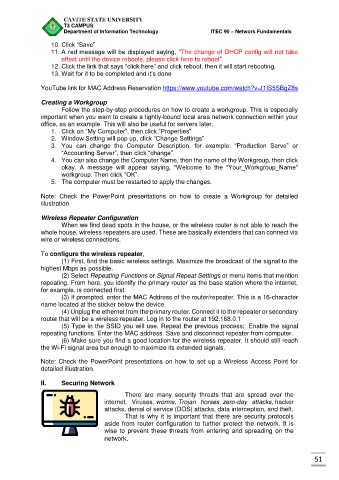Page 536 - PowerPoint Presentation
P. 536
CAVITE STATE UNIVERSITY
T3 CAMPUS
Department of Information Technology ITEC 90 – Network Fundamentals
10. Click “Save”
11. A red message will be displayed saying, “The change of DHCP config will not take
effect until the device reboots, please click here to reboot”.
12. Click the link that says “click here” and click reboot, then it will start rebooting.
13. Wait for it to be completed and it’s done
YouTube link for MAC Address Reservation https://www.youtube.com/watch?v=t1IS5SBgZ8s
Creating a Workgroup
Follow the step-by-step procedures on how to create a workgroup. This is especially
important when you want to create a tightly-bound local area network connection within your
office, as an example. This will also be useful for servers later.
1. Click on “My Computer”, then click “Properties”
2. Window Setting will pop up, click “Change Settings”
3. You can change the Computer Description, for example: “Production Serve” or
“Accounting Server”, then click “change”.
4. You can also change the Computer Name, then the name of the Workgroup, then click
okay. A message will appear saying, “Welcome to the “Your_Workgroup_Name”
workgroup. Then click “OK”.
5. The computer must be restarted to apply the changes.
Note: Check the PowerPoint presentations on how to create a Workgroup for detailed
illustration.
Wireless Repeater Configuration
When we find dead spots in the house, or the wireless router is not able to reach the
whole house, wireless repeaters are used. These are basically extenders that can connect via
wire or wireless connections.
To configure the wireless repeater,
(1) First, find the basic wireless settings. Maximize the broadcast of the signal to the
highest Mbps as possible.
(2) Select Repeating Functions or Signal Repeat Settings or menu items that mention
repeating. From here, you identify the primary router as the base station where the internet,
for example, is connected first.
(3) If prompted, enter the MAC Address of the router/repeater. This is a 16-character
name located at the sticker below the device.
(4) Unplug the ethernet from the primary router. Connect it to the repeater or secondary
router that will be a wireless repeater. Log in to the router at 192.168.0.1
(5) Type in the SSID you will use. Repeat the previous process: Enable the signal
repeating functions. Enter the MAC address. Save and disconnect repeater from computer.
(6) Make sure you find a good location for the wireless repeater. It should still reach
the Wi-Fi signal area but enough to maximize its extended signals.
Note: Check the PowerPoint presentations on how to set up a Wireless Access Point for
detailed illustration.
II. Securing Network
There are many security threats that are spread over the
internet. Viruses, worms, Trojan horses, zero-day attacks, hacker
attacks, denial of service (DOS) attacks, data interception, and theft.
That is why it is important that there are security protocols
aside from router configuration to further protect the network. It is
wise to prevent these threats from entering and spreading on the
network.
51

